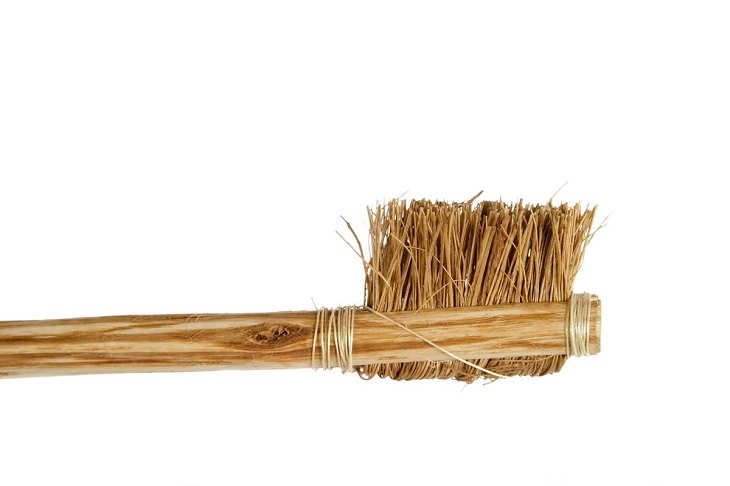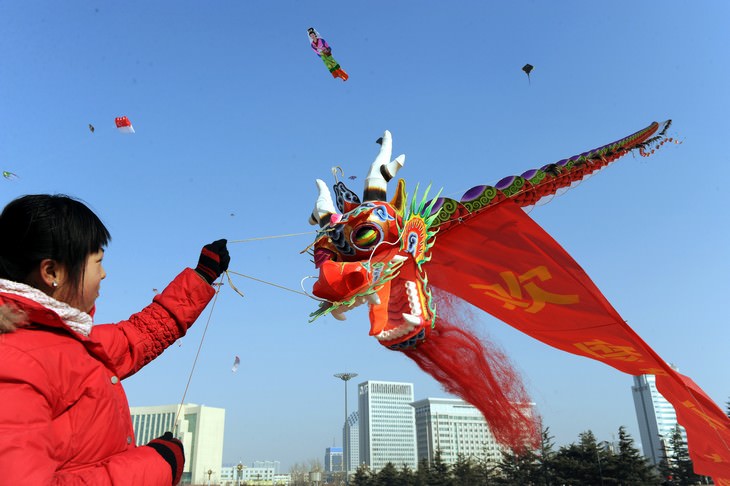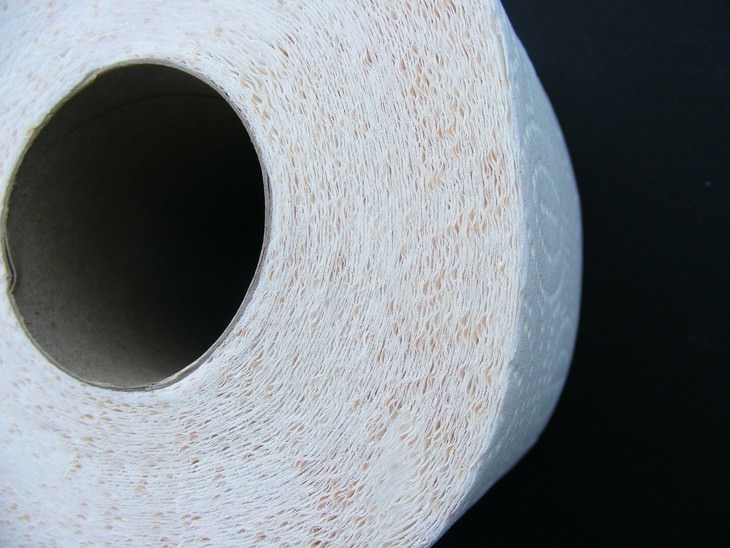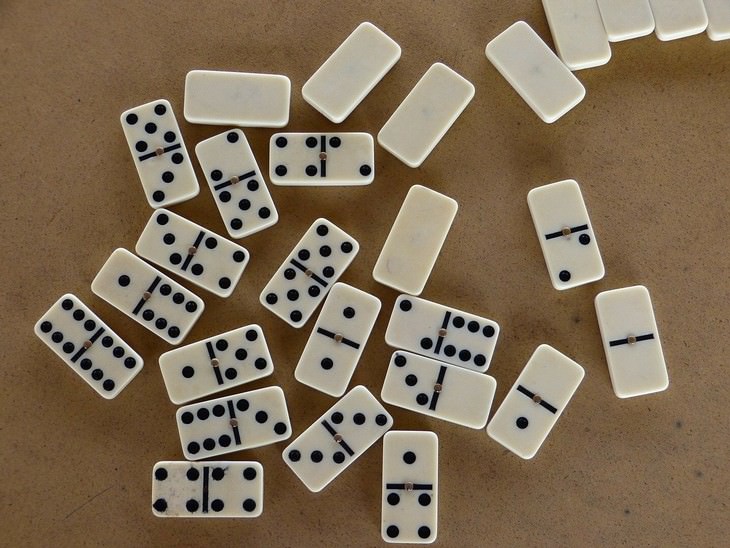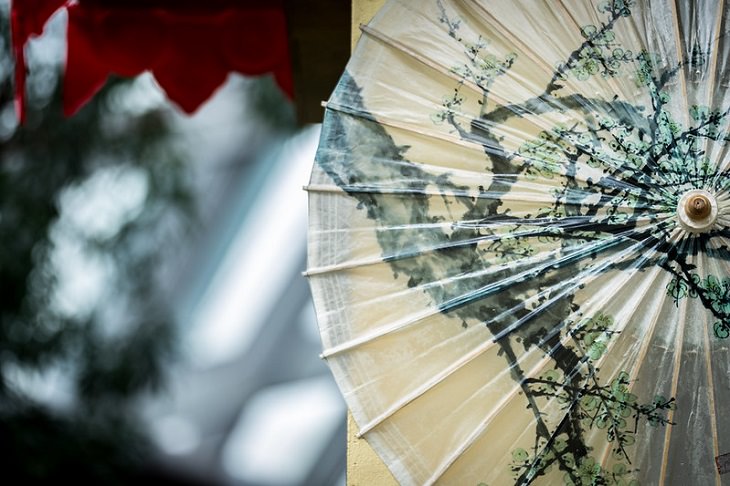1. Toothbrush
Dental care was tough in the distant past, especially if you happened to live in Northern Europe. Many countries weren't introduced to a toothbrush with bristles until after the Renaissance and were forced to make do with toothpicks, porcupine quills, bones, and feathers. If you were fortunate enough to live in China, India, the Middle East or Southern Europe, so-called chew sticks, which are essentially just twigs with a frayed edge, were available since 3,500 BC.
The first bristled toothbrushes were invented much later during the Tang Dynasty (619-907) in China. This proto-toothbrush had a bamboo handle and hog bristles, much like the replica in the image above. It wasn't until the 17th century that these tools were imported by Chinese merchants into Europe.
2. Kite
Kites are a traditional Chinese art, but the origins of this dare we say 'technology' dates back 3,000 years, where they were used as military tech. The first kites were made of wood and called Muyuan (a wooden kite). These were used for signaling, sending messages, testing the wind and measuring distances during military operations.
Later, kites evolved into an art form, and richly decorated kites featuring traditional mythological motifs and creatures we recognize today were made popular. These traditional kites remain an important feature of the Lunar New Year celebrations to this day, and kites, in general, have become a fun outdoor toy worldwide.
3. Banknotes
Paper money is such a given these days, but few people know that this is another one of those clever inventions we should thank the 7th century Tang dynasty and the 11th century Song dynasty for. The development of paper probably dates back to the 2nd century BC, but it was the excess of paper notes and the inconvenience of carrying around copper coins that collectively lead to the development of paper currency.
Since the 11th century, banknotes were in wide use in China, but it wasn't until the 14th century that paper money gained popularity among Italian merchants in the form of "banknotes" and "bills of exchange", but even these didn't gain widespread use until the 17th century.
4. Toilet Paper
Can you possibly imagine your life without this humble hygienic item? Well, if it wasn't for the inventive folk in 6th century China, chances are you wouldn't even use it today, and you'd be utilizing sponges soaked in vinegar, sticks, pebbles, or grass to clean yourself up like people did elsewhere until printing became popular in 17th century Europe and "excess" paper was made increasingly available to the masses.
5. Bell
Have you ever wondered where bells come from? If it seems like they have been around forever, you wouldn't be very far away from the truth, as the first archeological evidence of the existence of bells dates back to the distant 3rd millennium BC to the Yangshao culture of Neolithic China.
These first bells were made of pottery since they predated the invention of metal tools. Around 2,000 BC, the first bronze bells that are suggested to have had a cultural significance were created. Scientists aren't sure when the first bells were adopted in Western cultures, but Early Biblical and Ancient Greek and Roman records suggest bells were used for military and religious purposes.
6. Dominos
Even if you don't enjoy playing dominoes per se, we're sure you can at least enjoy a good domino fall video. While dominos may not be the oldest invention on this list, the first written mention of dominoes in China date back to the Yuan Dynasty (1271-1368), but the game was likely invented even earlier. Dominoes made their way to Europe only in the 18th century, becoming an instant fad in Italy, and the rest is history.
7. Dental Amalgams
As we have already established, dental hygiene and health weren't stellar in the distant past, but there is one invention in dentistry that is as ancient as paper money, and that is the dental amalgam, which is a mixture of metals used to fill cavities and prevent tooth decay.
The first mentions of dental amalgams date back to the Tang dynasty (619-907), with physician Su Gong writing about an amalgam made of tin and silver in 659, but it wasn't until 1528 that the technique arrived in Europe, with Dr. Strockerus registering it in Germany. Since the 1830s, the use of amalgams has been contested, since liquid mercury is used to produce them, but the technique seems to survive to this day.
8. Tea
Now, we do recognize that this one is not particularly surprising, and yet, tea is one of those things that are ubiquitous that we just had to mention it. Scientists believe that tea drinking likely began in the Yunnan region of China when it was used as medicine combined with other herbs at first but later came to be used as a stimulating drink rather.
According to Chinese legends, the invention of tea is attributed to the mythical deity called Shennong in 2737 BC in Central China, but archeological evidence points more towards southern regions of the country, and the first actual evidence of tea drinking dates back to 2nd century BC.
From China, tea-drinking was first spread to Vietnam, Japan and Korea around the 7th century, but it wasn't until the 16th century that the first Europeans were exposed to the drink. These were Portuguese priests and merchants, who knew the drink under the name "chiai", and by the early 17th century, the drink became a popular and very expensive imported good.
9. Restaurant Menu
While the origins of the first restaurants are highly debated, with Europeans being convinced that the concept began in 18th century France, there is evidence of restaurants having existed in China at least since the 11th century, and recent excavations in Pompeii suggest that 'fast food' stalls were quite popular in Ancient Rome.
But we digress, as the topic of this section is the history of the restaurant menu, the first mentions of which date back to the Song (960–1279) dynasty in China. With an increase in trade, restaurants in larger cities of the time had to cater to more customers than usual, many of which were not familiar with the meal selection in each place.
For this purpose, a list of meals was written down, and the first menus were created. The first French restaurant menus didn't appear until in the 18th century after the French Revolution.
10. Umbrella
The invention of the umbrella can be traced back to 2.400 years ago in China as well. According to a popular legend, Lu Ban, a Chinese carpenter was inspired by children using lotus leaves to shield themselves from the rain to create the first umbrella, which was made of a wooden framework covered by a piece of cloth. Umbrellas are also important attributes in imperial carriages. The first collapsible umbrellas were invented much later, around 21 AD.
The existence of umbrellas in Europe dates back to Ancient Greece and Rome, and there is evidence from Ancient Indian artworks, as well as Ancient Egyptian and Near Eastern records of umbrellas.
11. Imitation Meat
Nowadays, excluding meat from one's diet is not so difficult to do, even if you like your burgers and steaks, as many virtually indistinguishable meat alternatives are widely available worldwide. Have you ever wondered how and where the very idea of imitation meat began?
It all started with the invention of tofu during the Han (206 BC-220 AD) dynasty, and the spread of Buddhism may be partly responsible for its invention. Prior to that time, Chinese cuisine was very meat-based, but the advent of Buddhism, which largely favors a vegetarian diet, created a need for a meat replacement - tofu.
From China, tofu spread to other East Asian countries, but it didn't spread to Europe until quite recently. In Europe, meat alternatives were popular starting from the Middle Ages, as, during Lent, Christians were supposed to abstain from meat. Chopped almonds and grapes were used as a mincemeat substitute.
12. Fork
Are you surprised to learn that forks were invented in China? It's tru, the first forks were likely used as cooking utensils, and they were made of bone. The oldest forks were found on the archeological sites of the Bronze Age Qijia culture (2400-1900 BC). Similar utensils from the Shang dynasty (c.1600-1050 BC) were also found.
These first forks were two-pronged, much like the early Persian forks that can be found in the image above. The clever invention was spread through the Silk Road to Egypt, Persia and Ancient Greece and Rome, but it wasn't so popular in Christian Europe since the pitchfork was the sign of the devil. Forks weren't widely adopted in Europe and the Americas until Catherine de' Medici popularized the utensil in the 16th century.
Related Articles:

